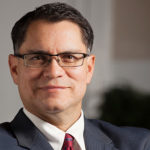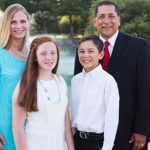SAN ANTONIO—Almost 500 years after he helped birth—and died for—the Anabaptist movement, Felix Manz, among others, was verbally resurrected at Baptist University of the Américas’ annual Rollins Lecture given by Karen Bullock, professor of Christian heritage at B.H. Carroll Theological Institute.
BUA was an appropriate setting since Manz and the movement’s early leaders were university students when their study of the Greek New Testament with Ulrich Zwingli launched a quest for the “true visible church,” resulting in the Anabaptist movement and the bitter and bloody persecution that followed. Its theological descendants today include Baptists, Mennonites and Amish.
Radical Reformation reformers commemorated
Bullock described Manz’s martyrdom: “As some in the watching crowded taunted, ‘You wanted to be baptized?’ he was taken to the Limmat River and rowed out to the fisherman’s hut in the center of the strong current. His hands were lashed to a stick tied to his knees and a rope was tied around his neck. Given an opportunity to speak his last, he quoted in Latin, ‘In manus tuas, Domine, commendo spiritum meum’(Into your hands, Lord, I commend my spirit). He was thrown into the icy water, drowned, retrieved and burned.”
His crimes included refusing to have his children baptized as infants—convinced instead that believer’s baptism was the mark of the New Testament Church—and for advocating separation of church and state and the refusal to take an oath of loyalty to any other than God. Ulrich Zwingli, Manz’s former mentor, endorsed the killing to protect his own reform movement, which seemed threatened by these young scholars who were calling for a swifter, more radical reform.
The Anabaptists, Bullock explained, were the Fourth Wing, “the underground wing” of the reformation of the Christian church. “Not the Lutheran wing, which gave us the Lutheran Church; not the English wing, which birthed the Anglican church; and not even the Reformed wing primarily, which first emerged in Zurich with Zwingli and eventually became the Reformed movement. But we celebrate today that underground Reformation wing, which also sprang from Zurich in those explosive days—the Biblical Anabaptists.”
Bullock maintains the Biblical Anabaptists, among all of the other Radical groups, took the most direct route to reclaim the gospel message, biblical ecclesiology and social action in the world, than any other radical reformed group of that era. They paid a bloody price. According to historian Justo Gonzalez, there were more Anabaptist martyrs in the 16th century than Christians in the 1st century under pagan Roman emperors.
Bullock’s use of the term “Biblical Anabaptist” draws a distinction between those who continued to hold the basic tenets of the first Anabaptists and those, also called Radical Reformers and Anabaptists, who later veered into wildly divergent theologies and discarded basic doctrines.
In Münster in 1534-35, followers of Melchior Hoffmann attempted to fulfill their “obligation” to set up the kingdom of God and destroy the ungodly, forcing out Catholics and Lutherans out of the city.
A string of new edicts declared Münster the New Jerusalem and proclaimed that all adult citizens who refused to be baptized “by faith” would be killed as “godless” and “wicked.” And they were. When the city was retaken, thousands of Anabaptists who had flocked to this New Jerusalem were slaughtered.
Sign up for our weekly edition and get all our headlines in your inbox on Thursdays
After Münster, a generation of moderate Anabaptist leaders—like Menno Simons—had enough influence to limit the radicals and lead the rest of the compromised movement in a peaceful and orderly direction and restored biblical Anabaptism.
This, along with turmoil within the Church of England, laid a foundation for Baptists.
In 1607, Separatist pastors John Smythe and Thomas Helwys fled with their congregation from Gainsborough, England, to Amsterdam to escape government persecution. They found welcome in a Mennonite bakery with Jan Munter and his congregation of Dutch Mennonites.
In 1609, Smythe, Helwys and the Separatist congregation disbanded their church and reconstituted their assembly as the first Baptist church, having a strong family likeness to the Anabaptists.
Radical Reformation lays foundation for Baptist beliefs and practices
Most Baptists in America today share eight of the nine major doctrines espoused by the earliest Swiss Brethren—the Biblical Anabaptists—in Zurich almost 500 years ago:
- The authority of scripture for faith and practice, opposed to creeds, dogmas, culture, reason or traditions.
- A New Testament model for the church—regenerate, responsible and voluntary church membership should be without coercion or arraignment by the courts.
- Believer’s baptism, as opposed to infant baptism.
- The Eucharist as a non-sacramental Solemn Memorial.
- The priesthood of all believers.
- Separation of church and state.
- Religious liberty for all and no civil punishments for religious heresies.
- Living “in the world, but not of the world.”
The exception is refusal to serve in the military, which is still a major tenet for Mennonites.
In 2004, Mennonite representatives from around the world were invited to a service where the Reformed church officially and humbly asked forgiveness for the violence that had been perpetrated against the Anabaptists for more than 300 years, admitting the guilt of their church for the actions.
The Anabaptist responded: “History may recognize us as victims, and could incite us to find satisfaction in that. However, those here among you today, direct descendants of those Anabaptists persecuted in the past, no longer feel as victims. We do not ask for material retribution for the past; that would seem to us to be contrary to the Spirit of the Gospel. But the fact that you recognize the difficult points of your history in relation to ours helps us to see ourselves and to meet you differently. We thank you, therefore, for your statement, and wish to accept it in a spirit of forgiveness.”
Bullock urged the BUA students to learn from and honor the Biblical Radical Reformers: “When considering the courage, the enduring faithfulness, the almost endless suffering this people of God have absorbed, it is perhaps the most telling characteristic of the Biblical Anabaptists that they forgave their enemies. And in this way, perhaps more than in any other, demonstrated whose they were, and still are; for their beliefs and actions and responses mirror the Jesus they serve. May God instruct us from their witness.”
Craig Bird is the director of special projects in academic affairs for the Baptist University of the Américas in San Antonio.














We seek to connect God’s story and God’s people around the world. To learn more about God’s story, click here.
Send comments and feedback to Eric Black, our editor. For comments to be published, please specify “letter to the editor.” Maximum length for publication is 300 words.